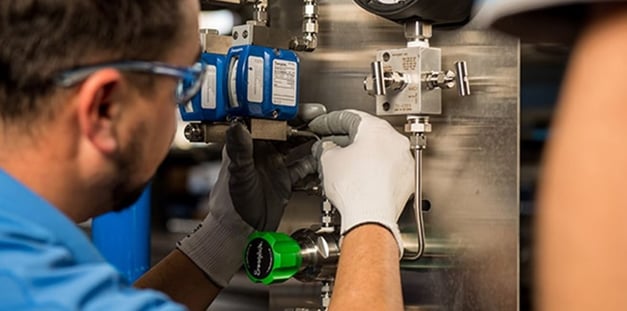Share this
When Should You Switch to a Dry Gas Seal Application in California Bay Area Refineries?
by Malik Durojaiye on 11/3/21 9:00 AM
 Running a new process in a refinery can be difficult in terms of engineering and operational challenges. The components of the processing operation should be effective and efficient at meeting processing needs. The system needs to be able to operate at peak performance with limited maintenance for as long as possible. Further, the processing operation needs to be compatible with the processing needs—that is, the components of operating need to be congruent with the temperature, pressure, and materials of the processing operation. With all this in mind, it can be difficult to make engineering choices for how best to meet processing needs.
Running a new process in a refinery can be difficult in terms of engineering and operational challenges. The components of the processing operation should be effective and efficient at meeting processing needs. The system needs to be able to operate at peak performance with limited maintenance for as long as possible. Further, the processing operation needs to be compatible with the processing needs—that is, the components of operating need to be congruent with the temperature, pressure, and materials of the processing operation. With all this in mind, it can be difficult to make engineering choices for how best to meet processing needs.
Consider utilizing a dry gas seal application for new processing operations. When implemented and operated correctly, dry gas seals require less maintenance than other options, have a long production life, and have the flexibility for a range of operational needs. Though engineering options for a dry gas seal application can seem daunting, a local expert can help with utilizing a dry gas seal and dry gas seal support system to make for a long-lasting efficient processing operation.
In this article, we will examine the benefits of a dry gas seal application, the engineering options for a gas seal support system, and the importance of having a local expert to meet dry gas seal support system needs.
The Benefits of a Dry Gas Seal
Dry gas seals are crucial for refinery operations; they separate process gas from other chemicals and components of processing. These seals have two faces that separate as gas flows across the faces of these seals, and this allows the dry gas seal to separate and close with minimal contact occurring between the faces. There are several benefits from this way of operating.
Long Production Life
Due to minimal contact between the faces of the dry gas seal, there is less wear and tear on dry gas seals as there is in other types of seals. This results in dry gas seals having a long production of life—around 10 years if dry gas seals are properly implemented.
Less Maintenance
Similarly, the minimal wear and tear to dry gas seals during operations means that less maintenance is typically needed to maintain operations. This not only limits maintenance costs but allows for operations to run continuously and efficiently which has large economic benefits.
Several Processing Options
Processing can involve many different chemicals. Some of these chemicals are heat sensitive, corrosive, toxic, or combustible. In many instances, the dry gas seal is the only option that can work with these chemicals while maintaining minimal risks to operations.
Flexibility in Operational Needs
Dry gas seals can be utilized for operations that need to be run continuously, semi-continuously, or only at distinct junctions. The temperature and pressure requirements of the system can also be accommodated by dry gas seals.
The dry gas seal on its own is not the end of the story for meeting operational needs. The dry gas seal support system must also be installed and operated correctly. We will now discuss the seal support system and the importance of its proper implementation.
Implementing the Appropriate Seal Support System for Dry Gas Seal Application
Dry gas seal support systems allow for efficient operations when properly aligned with seal configuration and processing conditions. The seal support system is important for several major tasks during operations including the following:
- preventing liquid from forming in the seal;
- monitoring the dry gas seal for leakage and alerting operators to gas leakage;
- containing gas leakage; and
- the continual function of managing the flow of gases to and venting the flow of processed gas from the dry gas seal.
Operational design relies on the dry gas seal support system. The seal support system and its components need to meet operational needs for the chemicals used and for the processing characteristics of operations.
Compatibility with Chemicals Used in Production
The materials used to construct a dry gas seal support system need to work with the chemicals used in operations. The chemicals used in operation are often corrosive and reactive to certain materials. A poorly implemented seal support system can lead to additional maintenance issues, risks of gas leakage, and system shut down.
Compatibility with Processing Characteristics
The dry gas seal support system must align with the pressure, volume, and flow of gas and liquids in operations. The materials of the dry gas seal support system need to be able to withstand the variation in temperature and pressure that occurs during operations. The flow of gas and liquids need to be properly controlled in order to prevent a build-up of pressure and leakage of chemicals to the surrounding atmosphere.
Component Considerations
The components of the dry gas seal support system include the compressor (which prevents gas leakage into the atmosphere), the seal panel (which monitors dry gas seal for leakage and monitors gas flow and pressure), and the rotating seat (which creates gas film stiffness). The selection of each of these components of the dry gas seal support system requires taking into account their interaction with other components of the system. For instance, the seal panel must be properly configured with the dry gas seal cartridge and with the constraints of the operation; the rotating seat may have space constraints based on the operational configuration. Further, the operational needs for the flow of gas (e.g. a continuous or discrete flow of gas) will impact the choice in many components such as which type of valves to use.
Switch to a Dry Gas Seal Application with Expert Guidance
Running a new process in refinery operations can be challenging. There are multiple engineering considerations that need to be made to achieve optimal performance. A dry gas seal application is often the best choice for long-term peak performance while lowering maintenance costs. Dry gas seals and dry gas seal support systems offer numerous engineering choices. For a dry gas seal application to be beneficial to the unique specifications and operational needs, it requires knowledge and expertise.
A local expert in gas seal systems can help identify the dry gas seal and the seal support system best suited for operations. They will consider the chemicals used in operations to avoid corrosion, the characteristics in operations (e.g flow, pressure, and temperature), and the overall goals of the operations. Swagelok has the local experts to help with all dry gas seal and dry gas seal support needs. Swagelok’s team of experience Field Engineers can ensure that new process operations cohesively work with overall operations.
To find out more about how Swagelok Northern California can help you with your dry gas seal and all your seal support system needs, contact our team today by calling 510-933-6200.

About Malik Durojaiye | Field Engineer, Assembly Services
Malik Durojaiye began his Swagelok career in 2019 as a Custom Solutions Engineer in our Assembly Services group. Prior to Swagelok, Malik developed as a design engineer as well as a manufacturing engineer for 6 years serving Kentucky and California with Altec Industries; a leading provider of products and services to the electric utility, telecommunications, tree care, lights and signs, and contractor markets.
Share this
- Archive (465)
- Assembly Services (207)
- About (100)
- Seal Support Systems (96)
- Best Practices (88)
- Training Services (74)
- Fittings (51)
- Semiconductor Applications (49)
- Hoses and Flexible Tubing (47)
- Regulators (44)
- Tubing (42)
- Grab Sampling Systems (32)
- Sampling Systems (32)
- Gas Systems (30)
- Services (30)
- Downloads (29)
- Valves (24)
- Application Support (18)
- Orbital Welding (17)
- Case Studies (13)
- Steam Systems (13)
- Frequently Asked Questions (12)
- Tools (12)
- Measurement Devices (7)
- Subsystems (6)
- Thermal Management (6)
- September 2023 (1)
- August 2023 (2)
- June 2023 (1)
- March 2023 (3)
- February 2023 (3)
- January 2023 (4)
- December 2022 (4)
- November 2022 (4)
- October 2022 (4)
- September 2022 (1)
- August 2022 (3)
- July 2022 (2)
- June 2022 (4)
- May 2022 (1)
- April 2022 (2)
- March 2022 (1)
- February 2022 (2)
- January 2022 (3)
- December 2021 (1)
- November 2021 (6)
- October 2021 (6)
- September 2021 (8)
- August 2021 (4)
- July 2021 (3)
- June 2021 (6)
- May 2021 (6)
- April 2021 (7)
- March 2021 (5)
- February 2021 (4)
- January 2021 (6)
- December 2020 (5)
- November 2020 (6)
- October 2020 (6)
- September 2020 (8)
- August 2020 (7)
- July 2020 (8)
- June 2020 (8)
- May 2020 (6)
- April 2020 (9)
- March 2020 (7)
- February 2020 (10)
- January 2020 (21)
- December 2019 (23)
- November 2019 (21)
- October 2019 (22)
- September 2019 (21)
- August 2019 (22)
- July 2019 (23)
- June 2019 (20)
- May 2019 (23)
- April 2019 (22)
- March 2019 (21)
- February 2019 (20)
- January 2019 (21)
- December 2018 (14)
- November 2018 (19)
- October 2018 (23)
- September 2018 (17)
- August 2018 (29)
- July 2018 (11)
- June 2018 (6)
- May 2018 (5)
- April 2018 (4)
- March 2018 (5)
- February 2018 (3)
- January 2018 (3)
- December 2017 (2)
- November 2017 (4)
- October 2017 (3)
- September 2017 (2)
- August 2017 (6)
- July 2017 (4)
- June 2017 (4)
- May 2017 (4)
- April 2017 (3)
- March 2017 (4)
- February 2017 (3)
- January 2017 (3)
- December 2016 (3)
- November 2016 (3)
- October 2016 (3)
- September 2016 (5)
- August 2016 (5)
- July 2016 (4)
- June 2016 (5)
- May 2016 (3)
- April 2016 (4)
- March 2016 (5)
- February 2016 (11)
- January 2016 (1)
- December 2015 (3)
- November 2015 (4)
- October 2015 (3)
- September 2015 (4)
- August 2015 (4)
- July 2015 (8)
- June 2015 (5)
- May 2015 (3)
- April 2015 (4)
- March 2015 (4)
- February 2015 (3)
- January 2015 (4)
- December 2014 (2)
- November 2014 (3)
- October 2014 (4)
- September 2014 (4)
- August 2014 (4)
- July 2014 (5)
- June 2014 (4)
- May 2014 (4)
- April 2014 (5)
- March 2014 (4)
- February 2014 (3)
- January 2014 (4)
- December 2013 (5)
- November 2013 (3)
- October 2013 (4)
- September 2013 (3)
- August 2013 (5)
- July 2013 (5)
- June 2013 (5)
- May 2013 (3)
- April 2013 (6)
- March 2013 (4)
- February 2013 (4)
- January 2013 (8)
- December 2012 (4)
- November 2012 (6)
- October 2012 (6)
- September 2012 (4)
- August 2012 (4)
- July 2012 (4)
- June 2012 (4)

.webp?width=210&height=70&name=StickyLogo%20(5).webp)